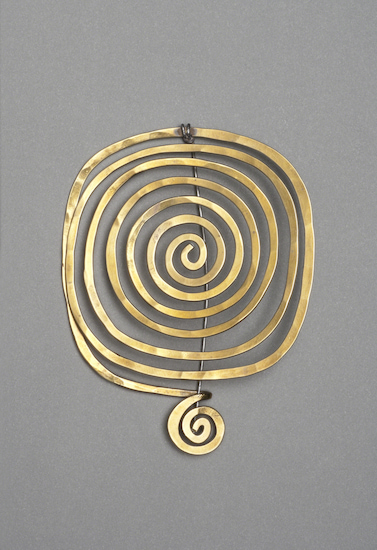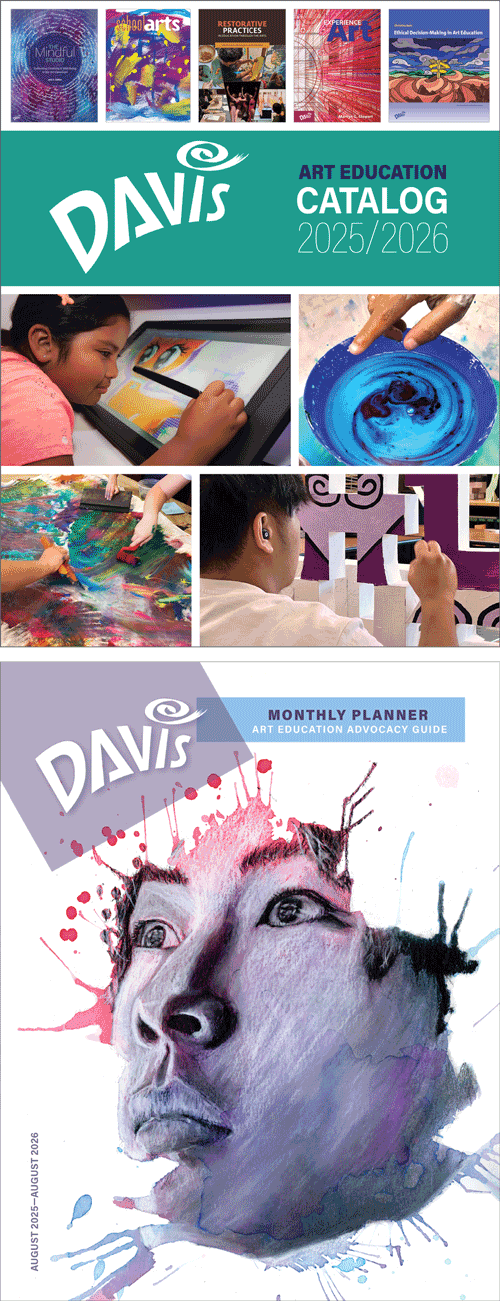Artist Birthday: Alexander Calder
Alexander is an artist who is renowned in art history for his pioneering exploration of movement in sculpture, and abstraction. He also became renowned for making jewelry which was a combination of modernism and the traditional forms of jewelry forms of ancient Egypt. Many of his jewelry pieces have a certain primordial elegance.
Artist Birthday for 22 July: Alexander Calder (1898–1976, United States)
Alexander Calder was a pioneer of kinetic sculpture, primary structures, fiber arts, and jewelry, among many others.
 |
| Alexander Calder, Brooch, ca. 1940. Hammered brass and steel wire, 10.8 x 8.1 cm. Philadelphia Museum of Art. © 2025 Calder Foundation, New York / Artists Rights Society (ARS), New York. (PMA-7724caars) |
Calder had broken tradition, using not the mallet and chisel, but rather shop tools of welding torch, wire cutters, and pliers. By the late 1920s, he applied this technique to a serious study of making jewelry. Calder first exhibited his jewelry in 1929 alongside his paintings and sculptures. Selling his jewelry at low prices was a way for Calder to earn a living while establishing himself as a sculptor. By the late 1930s, wearing Calder’s “wearable sculptures” became an artsy statement for society women in New York. His designs were unique and were not mass-produced.
These pieces of hammered metals are definitely reminiscent of the flat steel shapes seen in Calder mobiles. They also have the same playful, curvilinear shapes seen in Calder’s paintings and textiles designs. Such industrial material jewelry fit right in with the mid-century adulation of modern industry and the machine that was reflected in the trend called Art Moderne, a derivative of Art Deco.
At the turn of the 1900s in the United States, sculpture was under the stranglehold of academic classicism. This was particularly true after the 1893 Chicago World's Columbian Exposition which was a virtual extravaganza of Beaux-Arts Classicism and every other imaginable academic revival style. This entrenched classicist realism endured in the work of nearly all American sculptors up until World War II (1939–1945).
Despite that fact, there were some progressive tendencies in sculpture inspired by European modernism. These were brought to America by expatriates who had studied abroad, and by European artists coming to America. There were brief experiments with the romanticism of Rodin, the Art Deco formal experiment based on Cubism, Expressionism, Futurism and Dada, and some styles, like the wire constructions of Calder, that defied classification as to influence.
Calder was born the fourth generation of academic sculptors. During childhood he showed an early knack for constructing objects, such as tools, jewelry, animal figures and game boards from scavenged materials. He received a degree in mechanical engineering from the Stevens Institute of Technology in Hoboken in 1919. While working in the field of hydraulic engineering, he took night classes in drawing.
Eventually in 1923, he decided to be an artist, enrolling in the Art Students League. He initially emphasized painting. A drawing assignment to illustrate the Ringling Brothers Circus reinvigorated his childhood interest in animals and provided the impetus for sculptures throughout his career. In 1926 he published the book Animal Sketching.
Calder moved to Paris for a year in 1926. Between 1926 and 1931, mostly for self-amusement, Calder began to make moving toys and figures that eventually became his Circus. His Circus performances—in which he turned cranks to move the figures—were wildly popular in the avant-garde art world in Paris. They soon became popular as well in the US. The Circus, with its wire forms and movement, started Calder on the path towards a revolutionary exploration of abstraction in sculpture in the form of his mobile and stabile works. Surrealist artist Marcel Duchamp (1887–1968) coined the term mobile.
From the late 1940s on, Calder developed an increasing interest in monumental interpretations of his mobiles. Most of Calder's mobiles expressed movement because of air currents. The logical extension of that idea was one of architectural-outdoor mobiles, where wind would affect movement. The mobile was reconfigured as an autonomous standing structure combining a large, free-standing, usually pyramidal, base with with an attached mobile. Many of the titles of these monumental forms derived from nature.
In the late 1950s, Calder began to develop a non-moving derivative from these standing mobiles, called stabiles by the Surrealist sculpture Jean Arp (1886–1966). These large-scale works evolved out of the sheet-steel bases for his standing mobiles. Eventually, in the 1960s, these stabiles achieved the monumental proportions of Primary Structures.

Comments